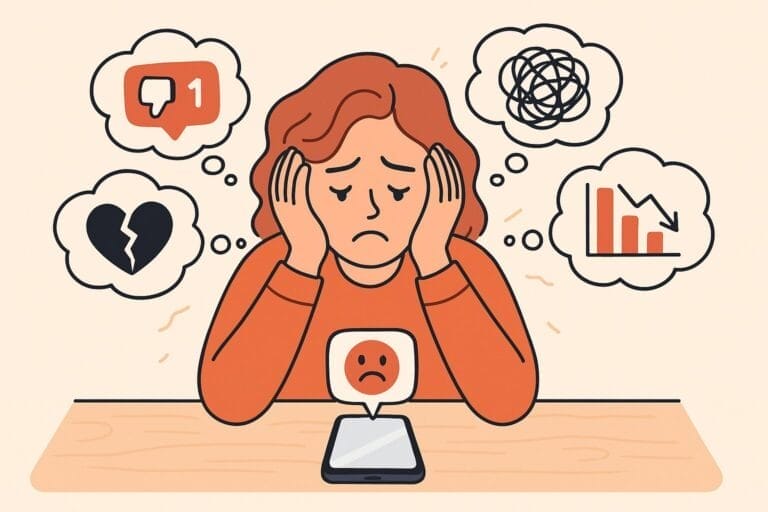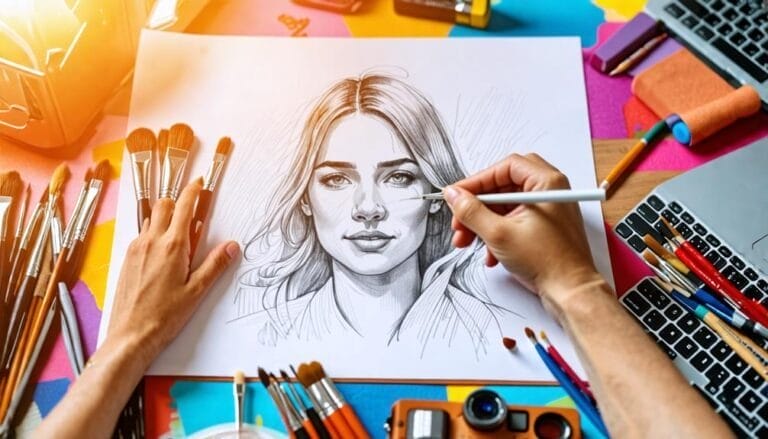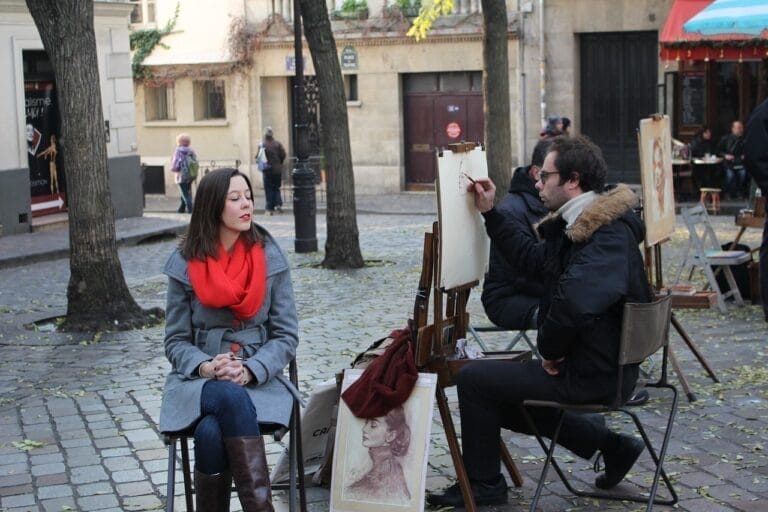As an artist, you’re driven by a passion to create and express yourself. But you also want to make a real difference in the world. Many artists struggle to balance their creative pursuits with the need to earn a living. However, with the right mindset and strategies, turning your art into a force for good is possible.
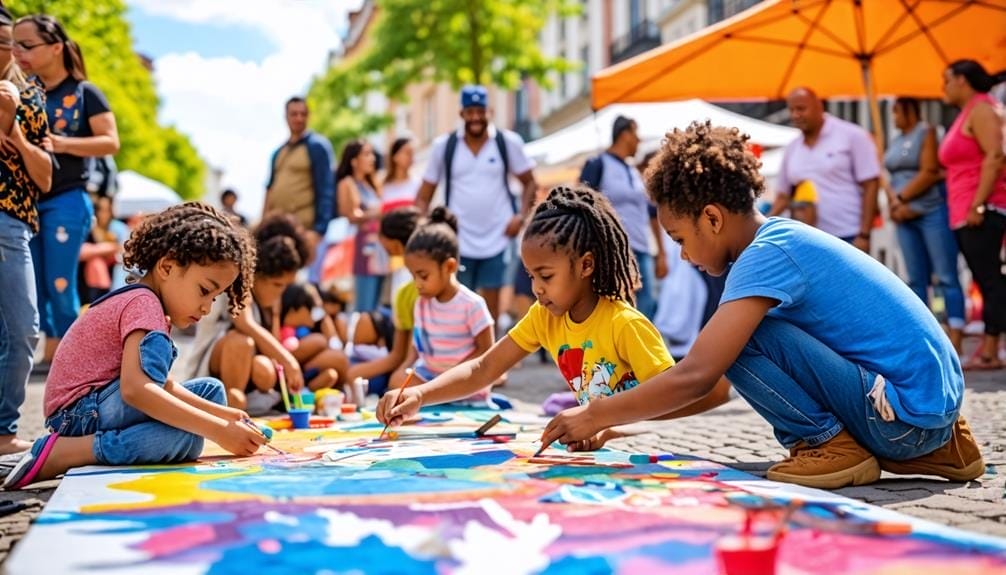
By engaging with your community and using your art to address social issues, promote positive change, and bring people together, you can earn a living while leaving a lasting impact. This approach benefits both you and the community you serve.
In this article, we’ll explore seven innovative business ideas for Artists to help you achieve this goal. From leading public art projects to offering art services for social impact organizations, we’ll show you how to turn your passion into a powerful tool for change.
- 1. Creating and Managing Online Art Communities or Forums
- 2. Transforming Neighborhoods through Public Art Projects and Murals
- 3. Offering Art Services for Social Impact or non-profit Organizations
- 4. Offer Art Tours or Walks in Local Neighborhoods
- 5. Develop and Lead Workshops on Sustainable Art Practices
- 6. Offer Art Therapy or Healing Programs
- 7. Community Engagement Art Residencies
DISCOVER MORE: 6 Online Business Ideas for Artists
1. Creating and Managing Online Art Communities or Forums

As an artist, have you ever felt isolated or disconnected from others who share your passion? Online art communities and forums can bridge this gap, allowing artists to connect, learn, and grow together.
Building a Vibrant Community
To get started, choose the right platform – social media sites, forums, or dedicated art-sharing websites. Then, focus on online networking strategies:
- Invite artists and art enthusiasts to join your community.
- Share interesting content regularly to keep members engaged.
- Use virtual exhibition platforms to showcase artwork from community members, creating excitement and encouraging participation.
Fostering Engagement and Growth
Member engagement techniques are essential for a thriving community. To keep members invested, try hosting virtual events like artist talks or Q&A sessions. You can create challenges or themed competitions to spark creativity and inspire new ideas. Encourage discussions by asking thought-provoking questions about art techniques or industry trends, fostering a sense of connection and collaboration among community members.
Moderation and Community Building – As you nurture your online art community, create a warm, welcoming space by setting clear behavior and content-sharing guidelines. Be approachable and responsive, addressing member inquiries and concerns in a timely and caring manner. Doing so will foster a supportive and inclusive environment where artists feel valued, respected, and inspired to grow.
The Social and Community Impact
These online communities can:
- Provide a safe space for artists to share their work, receive feedback, and support one another.
- Offer resources, tutorials, and webinars to help artists improve their skills and stay updated on industry trends.
- Foster collaboration and networking opportunities, leading to new art projects and commissions.
- Celebrate diverse artistic voices and styles, promoting inclusivity and representation.
Authority and Opportunities
As the founder and moderator of an online art community, you’ll establish yourself as an authority in the art world. This can lead to:
- Invitations to speak at art events or conferences
- Opportunities to curate exhibitions or art shows
- Requests for art critiques or mentorship
- Collaborations with other artists or organizations
The Business Opportunity
| Revenue Streams | Description |
|---|---|
| Membership Fees | Charge users for exclusive content, critiques, or resources. |
| Sponsored Content | Partner with art suppliers or organizations to promote their products or services. |
| Affiliate Marketing | Earn commissions by promoting art-related products or courses. |
By building a vibrant online art community, you’ll positively impact the lives of artists and the art world at large and establish a sustainable business model that aligns with your passions.
2. Transforming Neighborhoods through Public Art Projects and Murals
Public spaces are being transformed into vibrant reflections of community spirit, thanks to the creative expertise of artists.

Murals in urban alleys and sculptures in city parks beautify areas and foster community engagement and pride. Local authorities are increasingly turning to artists to bring their unique perspectives and talents to public art projects, resulting in spaces that truly reflect the heart and soul of a community. Examples include:
- The iconic Watts Towers in Los Angeles, a 100-foot-tall sculpture created by Simon Rodia
- The vibrant street art in Melbourne’s laneways, showcasing local and international artists
- The murals in Philadelphia’s Mural Arts Program, which have become a beloved part of the city’s cultural landscape
United States Post Office Murals
During the Great Depression, the US Treasury Department’s Section of Painting and Sculpture commissioned artists to create murals for local post offices across the country. This public art project not only provided employment for artists but also brought culture and beauty to rural communities.
Over 1,100 murals were created, showcasing American scenes and themes. These vibrant works of art continue to inspire and connect communities today, serving as a testament to the transformative power of public art initiatives.
As an artist, you can capitalize on this opportunity by developing and leading public art projects or murals, bringing your unique vision to communities and creating a lasting impact.
The Social and Community Impact – public art projects and murals can:
- Revitalize neighborhoods and boost local pride
- Provide a platform for community expression and storytelling
- Foster collaboration and inclusivity among residents
- Create a sense of ownership and accountability
The Business Opportunity
By leading public art projects or murals, you can:
| Revenue Streams | Description |
|---|---|
| Public Funding | Secure grants from local government programs or foundations. |
| Sponsorships | Partner with local businesses to support the project. |
| Commissioned Work | Receive contracts for large-scale public art projects. |
By turning public art into a business, you’ll create stunning works of art and build stronger, more connected communities.
3. Offering Art Services for Social Impact or non-profit Organizations
Imagine your artwork making a real difference in people’s lives. By offering your services to non-profit organizations, you can help social causes shine and gain exposure for your talents.

Many successful artists have started their careers by working with non-profits, gaining valuable experience, and building their portfolios.
For example, renowned graphic designer Milton Glaser began his career by creating posters for social causes, including his iconic “I NY” design.
Similarly, artist and activist Shepard Fairey cut his teeth by creating street art for social justice movements.
By partnering with non-profits, you can make a positive impact, launch your career, and attract new clients.
The Types of Projects Non-Profits Need Artists For
Non-profits require various artistic services to communicate their mission and impact effectively. Some examples of projects include:
- Designing logos, branding, and marketing materials to raise awareness and funds
- Creating illustrations, graphics, and infographics to communicate complex issues and data
- Developing visual campaigns for social media, fundraising events, and advocacy initiatives
- Providing art therapy services to support vulnerable populations, such as children, seniors, and those recovering from trauma
- Designing educational materials, such as brochures, posters, and educational kits
The Social and Community Impact
Non-profits work tirelessly to make a positive impact but often lack the creative resources to communicate their message effectively. Your art can:
- Help design impactful campaigns and materials
- Provide art therapy services to vulnerable populations
- Enhance fundraising events with custom art pieces
- Inspire change through public awareness initiatives
The Business Opportunity
| Benefits | Description |
|---|---|
| Exposure and Recognition | Gain visibility for your work and attract new clients. |
| Referrals and Word-of-Mouth | Build a reputation as a socially responsible artist. |
| Discounted Rates or Fees | Negotiate fair compensation for your services. |
By combining your artistic talents with social impact, you’ll make a difference and build a fulfilling and sustainable business.
4. Offer Art Tours or Walks in Local Neighborhoods
Art tourism is rising, with travelers seeking immersive experiences that showcase local creativity and culture. Your neighborhood is no exception, boasting a rich tapestry of art, murals, and street art waiting to be explored.

The general public is increasingly curious about the stories behind the art and the artists who create it. By developing and leading art tours or walks, you can cater to this interest and share your passion for local art.
Wynwood Walls Tour, Miami – The Wynwood Walls Tour in Miami is a premier art tour experience, showcasing vibrant street art and murals from world-renowned artists. This guided tour takes visitors through the Wynwood Arts District, exploring the largest outdoor art exhibit in the country.
- Impact: Boosted local tourism, transformed the neighborhood into a cultural hub, and created a unique experience for art enthusiasts.
- Revenue: Generates significant revenue through tour fees, merchandise, and partnerships with local businesses.
Imagine guided gallery tours, studio visits, and art demonstrations that bring the artistic process to life. Envision self-guided walks that uncover hidden murals and street art, providing a unique perspective on the neighborhood’s character. You can curate these experiences as an artist, fostering community engagement and supporting local businesses.
The Social and Community Impact
- Foster community pride and appreciation for local art
- Support local businesses and tourism initiatives
- Provide a unique platform for artists to showcase their work
- Enhance neighborhood revitalization efforts
The Business Opportunity
| Revenue Streams | Description |
|---|---|
| Tour Fees | Charge participants for guided tours or self-guided walk materials. |
| Partnerships | Collaborate with local businesses and tourism boards for promotion and revenue sharing. |
| Commissioned Work | Offer custom art pieces or murals for businesses and organizations along the tour route. |
How to Get Started
- Research your area’s artistic landmarks, murals, and galleries.
- Connect with local artists and get their permission to feature their work.
- Create a compelling narrative that weaves together art and local history.
As you plan your tours, focus on diverse artistic expressions. Include street art, sculptures, and architectural features. Don’t forget to highlight lesser-known artists and hidden gems. Your knowledge of the area’s cultural background will add depth to the experience.
5. Develop and Lead Workshops on Sustainable Art Practices
The world is shifting towards a more eco-conscious future, and the art world is no exception. As concerns about waste management and environmental sustainability grow, artists, schools, and communities seek ways to create responsibly. The demand for sustainable art practices is on the rise, with many looking for ways to reduce their ecological footprint.

In response, workshops on sustainable art practices are gaining popularity. These workshops teach eco-friendly techniques, material reuse, and sustainable practices, empowering artists to create art that inspires and protects the planet.
By developing and leading such workshops, you can cater to this growing demand and positively impact the art world and the environment.
The Social and Community Impact
- Foster environmental awareness and responsibility
- Promote creative reuse and recycling
- Support local green initiatives and community engagement
- Inspire a new generation of eco-conscious artists
Real-Life Impact
The demand for sustainable art workshops and practices is growing, as evidenced by several sources highlighting the positive impact of environmentally friendly art on reducing waste and improving sustainability.
- Art consultancy Artelier notes a significant push towards sustainability across various industries, including art. This movement is about integrating sustainable practices into luxury contexts, using natural materials and innovative techniques to create eco-conscious artworks.
It’s a response to consumers who want art that inspires and protects the planet. As a result, artists, galleries, and collectors are rethinking their approach to art creation, exhibition, and consumption, paving the way for a more environmentally responsible art world. - Portfoliobox discusses how environmentally friendly art is reshaping the art market, with collectors and galleries increasingly valuing sustainable art practices. This shift is opening new opportunities for artists to engage with socially responsible consumers and participate in exhibitions focused on eco-art, thereby enhancing community engagement and awareness.
These sources collectively support the premise that sustainable art workshops are in demand and significantly impact reducing waste and promoting environmental consciousness in the art world.
The Business Opportunity
| Revenue Streams | Description |
|---|---|
| Workshop Fees | Charge participants for online or offline classes. |
| Partnerships | Collaborate with local art centers, schools, and environmental groups for resources and promotion. |
| Eco-Friendly Products | Sell sustainable art materials and supplies to workshop participants. |
Sharing your passion for sustainable art will create a positive impact, build a loyal community, and establish a thriving business.
6. Offer Art Therapy or Healing Programs
Art has long been recognized as a powerful tool in the healing process. It provides an outlet for emotions, fosters self-expression, and promotes relaxation and calmness. As a result, art therapy has become an increasingly popular approach in healthcare and community settings.
Communities seek innovative ways to support mental health, wellness, and social development. Art therapy programs are in high demand, with hospitals, mental health organizations, and community centers looking for skilled artists to lead sessions.
The Social and Community Impact
Art therapy programs:
- Provide emotional support and comfort to marginalized communities
- Foster healing and recovery in hospitals and mental health organizations
- Promote self-expression and empowerment for individuals with disabilities
- Bring people together, building stronger, more compassionate communities
Case Study: The Arts & Healing Program at the National Gallery of Art
The National Gallery of Art in Washington, D.C. offers an Arts & Healing Program for individuals with Alzheimer’s disease and their caregivers. The program combines art viewing, discussion, and creation to promote cognitive stimulation, emotional expression, and social engagement. Results are impressive:
- 90% of participants reported improved mood and reduced stress
- 85% showed increased social engagement and interaction
- 80% demonstrated improved cognitive function and memory recall
- Caregivers reported reduced caregiver burden and increased sense of connection with their loved ones
Quote from a Participant:
“The arts program has been a lifesaver for me and my husband. It’s brought us closer together and given us a new way to communicate.” – Arts & Healing Program Participant
The Business Opportunity
| Revenue Streams | Description |
|---|---|
| Session Fees | Charge organizations for art therapy sessions. |
| Partnerships | Collaborate with healthcare professionals for referrals and joint programs. |
| Grants and Funding | Apply for grants supporting art therapy initiatives. |
Sharing your passion for art and healing will create a positive impact, build a loyal community, and establish a thriving business.
7. Community Engagement Art Residencies
Art residencies bring artists into communities to create, teach, and engage with local residents. These residencies can take place in schools, community centers, or public spaces, and often focus on social issues or community empowerment.
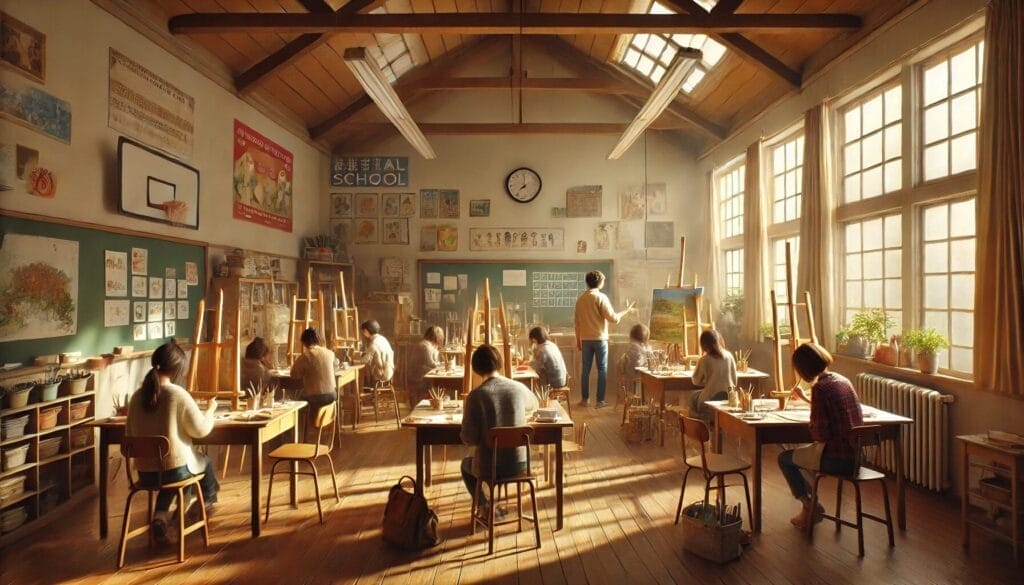
As an artist, developing and leading community engagement art residencies can be a rewarding business opportunity. It allows you to share your passion for art while making a positive impact.
The Social and Community Impact
- Foster social cohesion and community pride
- Provide a platform for marginalized voices to be heard
- Promote empathy and understanding through art
- Empower individuals and communities to drive positive change
The Business Opportunity
By developing Community Engagement Art Residencies, you can:
| Revenue Streams | Description |
|---|---|
| Grants and Funding | Secure support from foundations, government agencies, and corporations. |
| Sponsorships | Partner with local businesses and organizations for resources and promotion. |
| Crowdfunding | Leverage platforms like Kickstarter or Indiegogo to raise funds from community supporters. |
By leveraging art to drive community engagement and empowerment, you’ll create a lasting impact, build a loyal community, and establish a thriving business.
Take Action…
You have plenty of options for engaging your community through art. Start an online forum, lead a public mural project, or offer your skills to non-profits. Take people on art walks around your neighborhood. Teach others about eco-friendly art practices.
These ideas for artists will help you connect with locals, share your passion, and make a positive impact. Remember, art can unite people and create lasting change in your community.

